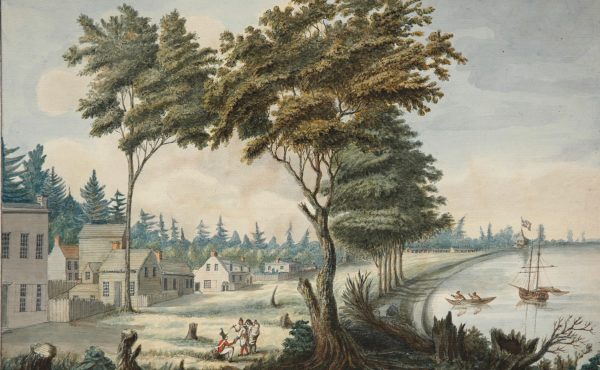Pedestrians will take the shortest available route where they need to go. And there’s really no reason why they shouldn’t be able to. There’s a famous anecdote about a Harvard park. In order to decide where to put the paths, they waited for it to snow and looked at where people trod down the snow and made paths naturally. Then they paved where people walked. It’s a sensible philosophy — put paths where people want to go.
You don’t really need to wait for snow — you can just watch what parts of the grass get worn down. In our own university in downtown Toronto, there is a lovely bit of green called Philosopher’s Walk that follows the bed of a former creek. It used to follow pedestrian philosophy — put the paths where people want to walk. But that wasn’t good enough for someone at the University of Toronto.
The University decided to re-locate two pillars from the site of the old greenhouses at College and University (demolished taken down to make way for the Leslie Dan Pharmacy Building) to Philosopher’s Walk. Fair enough, but they also decided the pillars needed some sort of grandiose entranceway with plantings and a semi-circular entrance, completely out of character with the park. The only way they could fit it in was to tear up the existing, logical paths. They decided the fancy design should trump the praticality of having paths where people go.

Observe the picture above. See how the natural path heading to the right, which used to go to the street for people heading west, has been blocked by grass (so that the brick paving now leads nowhere). People heading west are expected to take a detour to the left through the fancy new entrance in order to get where they need to go. It’s not huge detour, but there’s still no good reason for it. The university has actually put up a butt-ugly tall chain link fence to the right (not visible in the picture), because they know people will naturally walk across the grass the shortest route and create a new path. So much for making the entrance elegant. Why not just leave the path where people walk?

And here’s another pointless exercise. From Philospher’s Walk, there’s a well-worn path leading to the entrance to the law school. It’s been there ever since the law school’s extension was built almost twenty years ago. You’d think that, logically, the thing to do would be to leave it, or pave it. But the fancy new lanscaping blocks the natural path people would take. So instead they turfed over the path half-way up. The absurdity of the exercise is evident in the picture to the right. Since this picture was taken, the path has already started to be worn back in.
You’d think, of all places, that Philosopher’s Walk would follow the philosophy of walking.




12 comments
Most of the worn paths to get to the best areas where I live (in Malvern) get torn up and have houses and apartments built on them. There’s still one path that goes through an empty lot that is still used by everyone.
And when they do build things in the way of paths, that dosen’t stop people from tearing the fence they put up just to get the shortcut back.
Yay for urban sprawl. =\
The old U of T greenhouse wasn’t demolished. From an October 2004 press release on the City of Toronto’s website: “In an effort spearheaded by Ward 27 Councillor Kyle Rae, the University of Toronto’s historic botany greenhouse was dismantled and removed from its original location on the St. George campus in 2002 and relocated to Allan Gardens in early 2003. The relocated structure has been completely restored and retrofitted to provide a unique hands-on teaching environment for children to learn about horticulture.”
Whatever it may have done to the pathway, I disagree that the new entrance is out of character. Rather, it’s a nice bookend to the equally, if not more, grand Bloor St. gate.
Another UofT path issue is Queens Park. There is a pathway that is paved that leads directly from the lights in front of Victoria College to Hart House, but there are no lights on the Hart House side so the park (the city? the university? the provincial legislature?) decided to pave this path (probably because it became so muddy in the spring) but refuses to salt ot or plow it in the winter which results in a long slick icey corridor that people still walk along despite the plowed and salted paths that radiate directly from the statue in the centre. I think their logic is that people should go down to the safer crossing as Wellesley and take the underpass to Hart House Crescent…but that takes you over 100 metre out of your way to directly the front doors of Hart House. Of course no one does it.
That entire western side of Queen’s Park Crescent is in dire need of some reorientation to make it more pedestrian friends and make Queens Park more practical.
I think it’s very, very pretty (I agree with you, Mike, and think that philosopher’s walk could use some revitalization – it’s gorgeous but undermaintained compared to the rest of U of T) but a little impractical, for all the reasons you’ve listed.
One thing I’ve noticed about U of T since I’ve been there: nobody gives a shit about where the paths are, as Dave said. The fastest way to get from A to B that doesn’t involve going through walls ends up being followed. That means plants get trampled, grass stomped on, all that fun stuff. It won’t matter to your average U of T student that the path has been altered; they’ll alter it back themselves.
(Including any and all fences. I’ve seen it. I swear, some people must just walk around campus with wire cutters)
Many years ago when I attended planning school, our urban design professor called them ‘cat paths’ — those trails that occur where people naturally walk rather than where pavement and bricks program them to tread. His view was that designers should (a) anticipate human nature when planning open spaces and walkways; and/or (b) accommodate natural walkways when they do occur, given the large amount of coercive energy required to alter their behaviour (the chain link fencing required along Philosophers’ Walk is a very good example).
Incidentally, running across our front garden is a narrow, crooked path made by actual cats preferring the soft undergrowth to the sidewalk. And as a child I used to follow raccoon ‘tunnels’ across the wooded terrain near our home. These paths would always meander curiously, following a natural iconography (tree scents, concealed stones, old corn husks) I could never fully read.
Jonathan > Yeah, I know some of the greenhouses were moved. I should have said they were “taken down”.
Mike and David > I think the north entrance is great, but I feel it has a different quality to it. I’d say that if they’d just used the two pillars without the semicircle, it would have been more in character. To me, the south entrance is more in the style of the much-critized new south entrance to King’s College Circle on College. But that’s all just personal taste, and perhaps I’m biased by the whole pathways thing.
The University did a very nice, understated re-fit of Philosopher’s Walk in the 1990s, when they put in the brick pavers, the ramp at the north entrance, and the little circle with benches in the middle. I thought that re-fit got it just right.
Amy > I wish the university had consulted your planning prof.
The park in the triangle west of the Gooderham Building (Wellington, Scott, Front) memorializes paths for walking patterns that don’t exist any more. When this park was laid out, there were two well-established paths across the grass — I know, because I walked them all the time.
One went from the northwest corner to the southeast, and handled traffic from Royal Insurance (NW corner of Scott & Wellington where I worked at the time) to The Hayloft (a steak house where many staff spent their lunch hour). The main building door used to be on Scott rather than on Wellington.
The other went from the northeast corner of the park to the southwest, and linked Vines (a winebar) to the St. Lawrence and O’Keefe Centres.
These paths are now set in concrete, but none of the original traffic that generated them still exists.
There’s an interesting example of cat paths on the OCAD “campus”. Under the tabletop structure there’s a cement-block path running southwest from McCaul to the Grange sidestreet deadending at the park. It’s actually a really handy path, as otherwise you’d have to go around Aboveground Art Supplies, but unfortunately the administration chose cement patio blocks two-wide, which sink into the soil, aren’t wide enough for parties to pass, and are laid with several inches between, which is a tripping hazard waiting to happen.
Just this week somebody destroyed a fence that had been blocking a pathway which is “under construction” between Hoskin and University College, west of the UC field.
I hate those gates. While the central pillars are nice, they’ve chosen to try and replicate them in miniature with concrete (you can see the results on either side in the first photo). It looks terrible, especially next to an all-stone building like Trinity College. With the amount of money spent on those ridiculous gates at King’s College, you’d think they’d have a little money left for some stone.
Another thing wrong with the gates, as you’ll see if you examine the first photo closely, is that once through the gates, going southwards, the path doesn’t continue to straight to the sidewalk. There is in fact a tree in the way, and while I’m glad they didn’t cut it down the planner’s solution was an “elegant” branched path, curving to either side and forming a semicircle around it (as seen in the second photo). I don’t know about anyone else, but given that all pedestrian traffic is probably heading west or east (if only for a few metres in the latter case) I don’t understand why both branches end perpendicular to the main sidewalk. It’s just another corner to cut, and another slowdown. on an already roundabout route.
Couldn’t they have found another place to stick them? I don’t think Trinity would have been averse to having them on either side of the provost’s driveway. Or maybe on one of the paths they’re always working on near Knox or UC, or at the pedestrian crossing by the Trin chapel? Or even just further in the foreground of the first picture. As it stands, the concrete surround and self-important geometry just make the pillars look tacky.